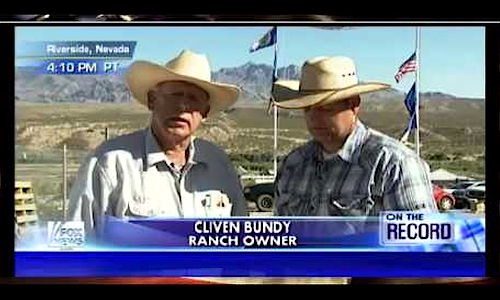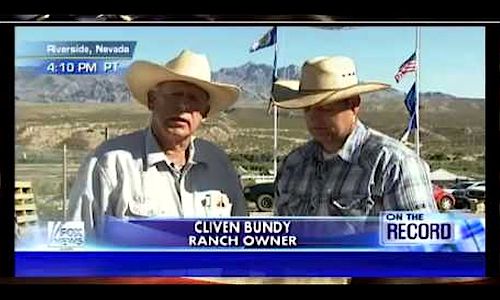

A 20-year feud between private rancher Cliven Bundy, 68, and the Bureau of Land Management (BLM) turned violent late last week when hundreds of armed Americans came together in support of Bundy, whose cattle were being removed from federal land by court order for illegal grazing.
The mass of armed citizenry, as well as threats made against local business owners, prompted bureau officials to announce over the weekend that the agency had decided to immediately stop its cattle roundup operations and try once again to reason with Bundy in court.
Specifically, a 20-minute standoff on Saturday, in which supporters of the rancher were pointing rifles toward the federal law enforcement officers and vice versa, raised serious safety concerns for the federal agency.
Between April 5 and April 12, federal officials reported that federally contracted wranglers impounded some 400 head of cattle from the federal land. But on Sunday, BLM Chief Neil Kornze announced that as part of the halt to the cattle roundup, the bureau had released all of the cattle that had been removed.
The federal government had been removing Bundy’s cattle and impounding them in a corral in nearby Mesquite, NV, because the rancher has kept his more than 900 head of cattle on a piece of 600,000-acre federal land for the past two decades and has refused to pay taxes since 1993, when the federal government increased the grazing fees in order to save critical habitat for the endangered Mojave Desert tortoise.
While the federal government allows grazing on federal lands, with the BLM reporting it administers around 18,000 grazing permits and leases on 157 million acres across the country each year, Bundy doesn’t have such a permit and hasn’t had one for the past two decades.
Bundy does not have such a permit because he doesn’t want to pay federal taxes on land he says belongs to the state of Nevada. However, the private rancher hasn’t removed his livestock from the federal land, which was an option he could have pursued in order to not pay the federal fee, which costs about $1.35 per cow-calf pair per month.
The feds argue Bundy owes U.S. taxpayers more than $1 million in unpaid grazing fees. As Kornze said, the cattle roundup was a “matter of fairness and equity, and we remain disappointed that Cliven Bundy continues to not comply with the same laws that 16,000 public-lands ranchers do every year.”
The rancher has refused to pay the money he owes or remove his cattle from federally-owned land, since he believes federal grazing fees infringe upon state rights. Bundy also argues his Mormon family has owned the land located about 80 miles from Las Vegas since the 1800s—before the creation of the Department of the Interior and before the government tried to save endangered species, which he says should make him immune from having to pay these federal taxes.
In response to Bundy’s argument, officials from the National Park Service and BLM have pointed out that the removal of the cattle is based on two U.S. District Court orders from two different judges, the first of which was issued in 1998, yet Bundy has thus far failed to comply with the order. But the federal officials’ message has been lost amongst the claims of a police state and an overreaching federal government from Bundy’s supporters, which has included conservative media outlets.
States vs. Feds
As a result of the federal government’s “battle” against Bundy, members of various militia groups from states including Virginia, Texas, Montana, Idaho and Wisconsin took it upon themselves to travel to Bundy’s ranch and support the rancher with their weapons, in order to prevent the federal government from infringing upon the state’s rights.
Stephen L. Dean, 45, of Utah, is a member of a militia group known as the Peoples United Mobile Armed Services. He said he came to Nevada because this is an example of “tyranny in government” by the BLM “stealing people’s cattle.”
What’s interesting about Dean’s concern about the “stolen” cattle, which are reportedly worth about $1,000 each, is that Bundy himself has said he is not concerned about the animals. Instead, his anger stems from the “infringement” upon state rights by the U.S. federal government.
“I’ve been fighting this for a number of years. It’s not about my cows, I’ll tell you that much,” Bundy said at a town meeting last Wednesday. “It’s about freedom and liberty and our Constitution … and above all it’s about our policing power. Who has policing power today?
“I love you people. And I love this land, and I love freedom and liberty,” Bundy said. “I know without doubt that our Constitution didn’t provide for anything like the federal government owning this land, and so when I pay my grazing fees—if I owe any grazing fees—I will sure pay it to the right landlord, and that will be to Clark County, Nevada.”
But as some have pointed out, if Bundy is going to get technical about who owns the land his cows are grazing on, he may want to have a conversation with Mexican government officials or Native American tribal members and send his money to them.
Loss for the Environment
While those who supported Bundy in Nevada and on social media sites were thrilled with the announcement that the BLM had decided to end its roundup and called the feds’ “retreat” a win for those opposed to an overreaching federal government, the announcement came as a devastating loss for some environmentalists.
For Rob Mrowka, an ecologist and senior scientist with Nevada’s Center for Biological Diversity, the agency that sued in federal court to remove Bundy from the federal land in order to protect the land and the tortoise, said he was disappointed to see the government give in to “an armed anarchist group,” instead of protecting the endangered tortoise and rare plants and allowing fire-damaged vegetation to regrow.
“The BLM has a sacred duty to manage our public lands in the public interest, to treat all users equally and fairly,” Mrowka said. “Instead it is allowing a freeloading rancher and armed thugs to seize hundreds of thousands of acres of the people’s land as their own fiefdom.”
“The BLM is setting a dangerous precedent in announcing that it will pick and choose who has to follow federal laws and who it will reward for violating them.”
Mrowka also expressed empathy for the federal agents who were on the front lines of this battle.
“They’re trying to uphold the law and do what’s right for the land, but their leaders have pulled the carpet out from under them again,” he said.
The Center for Biological Diversity had also filed a notice of intent to sue the BLM after canceling a planned roundup of Bundy’s cattle at the last minute in April 2012, illustrating that tensions between federal officials and Bundy are much deeper than the public may have realized.
Political Mud-Slinging
While Republican U.S. Sen. Dean Heller and Republican Gov. Brian Sandoval both released statements supporting Bundy, Democratic Sen. Harry Reid was noticeably quiet throughout the ordeal, prompting some to wonder what sort of interest the Senate Majority Leader may have in removing the cattle from the land.
Some suggested that Reid was silent because his former aide, Neil Kornze, was just confirmed as head of the BLM last Tuesday, but since this issue has been ongoing since the early 1990s, it’s likely Kornze’s connections to Reid were not solely responsible for the senator’s silence.
Others, such as right wing media outlets, accused Reid of working with the bureau in order to help his son, who was recently hired by a Chinese firm, to establish a solar power plant on the land. But it should be noted that those conservative news outlets spreading a pro-Bundy message are being supported by the Koch brothers—two billionaires Reid has publicly pledged to expose for all of their greedy misgivings.
Conservative media outlets are also reporting that this land is being seized by the feds in order to allow for more oil drilling and hydraulic fracturing, or fracking, on private land. However, there is currently no further evidence proving that is the government’s true motivation for removing the cattle.
However, as Daily Kos member Vyan wrote in a blog post, Bundy’s decision to use federally funded resources such as grass and water to feed his cattle without paying his fair share is no different than the “welfare moochers” conservatives often complain about. He’s using federal resources even though he doesn’t meet the requirements to access those resources.
“That’s MY Land that his cows have been grazing on for 20 years and he OWES ME and the rest of the American People for it,” Vyan wrote.
Alan O’Neill, a former superintendent of the Lake Mead National Recreation Area in Nevada, agrees. He wrote an opinion piece in the Las Vegas Sun explaining why Bundy is a bully and not a hero. O’Neil wrote:
I served as superintendent of the Lake Mead National Recreation Area for the National Park Service from 1987 to 2000. In 1993, we reduced the number of cows that could be grazed on the Bunkerville allotment to 150 because of the emergency listing of the desert tortoise as an endangered species. Because Bundy refused to remove his cattle to meet the 150 level and ignored repeated requests to do so, his permit was canceled in 1994 and the allotment was closed to grazing.
It is unfathomable to me that 20 years after the Bunkerville allotment was canceled in 1994, we are still wrestling with getting his cattle off the range. And there were issues of overgrazing that allotment before 1994. It is my opinion that the BLM and the Park Service have done everything possible administratively to try to resolve the issue amicably. In addition, there are two federal court rulings upholding the agencies’ position, and the most recent ruling demanded Bundy not physically interfere with any seizure or impoundment operation.
Bundy is a bully who has used his threat of a range war and to do “whatever it takes” to stop the government from impounding his cattle to scare public officials … What Bundy is doing is a criminal act, and he should be accountable for his actions rather than be held up as a hero fighting the federal government.
——–
YOU MIGHT ALSO LIKE
10 Wilderness Protection Bills Stalled by Congress
U.S. Wildlife Services Kills 1.5 Million Animals Each Year With No Public Accountability
BLM Fails to Comply With Court Order, Refuses to Change Transparency Policy
——–

 233k
233k  41k
41k  Subscribe
Subscribe 
